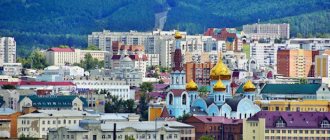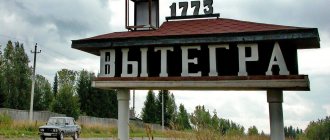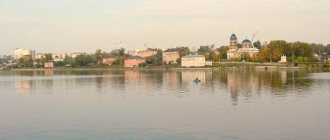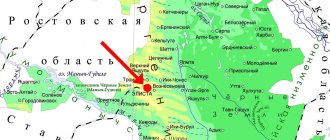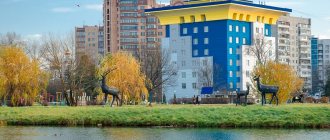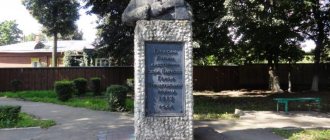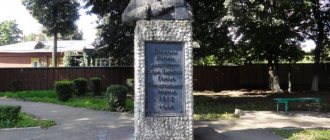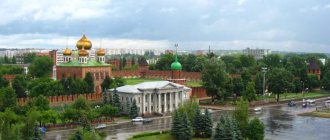Sights of Solikamsk Good afternoon, dear reader! Dmitry is in touch.
This article is dedicated to the sights of Solikamsk. This is an ancient city in the Perm region, its main “salt shaker”.
The city of Solikamsk was founded at the beginning of the 15th century, when the Kalinnikov trading people, immigrants from Vologda, moved their salt pans from the upper reaches of the Borovaya River to the Usolka River. Here a settlement was founded in 1430, first named Sol Kamskaya, Usolye Kamskoye, and later Solikamsk. Salt production has been the leading sector of the city's economy for several centuries.
Usolka River, Solikamsk
The Usolka River flows through the city of Solikamsk (see photo above). And our first stop is precisely on the bank of Usolka, near the Lyudmilinskaya well. Why here?
Lyudmilinskaya well
The Lyudmilinskaya well is not just one of the interesting sights of the city of Solikamsk. This can be said to be the symbol of this city. After all, it was from here that the history of the development of a large deposit of potassium-magnesium salts on the Upper Kama began.
Sights of Solikamsk - temples, houses, museums
A white-stone fairy tale: harmonious compositions with echoing leitmotifs of paired buildings, delicate patterns like skillful embroidery on the white canvas of the walls - temples worthy of the capital - the salt capital of Russia. Wonderful views involuntarily transport you back several centuries, to the 17th-18th centuries, the heyday of Solikamsk. But not for long, because the 20th century. greatly changed the appearance of the city: a multi-storey industrial center grew from an elongated fishing village. The sights of Solikamsk attract tourists from all over the country.
A Russian Orthodox city that remembers the era of its prosperity and copies it in more modern buildings, many churches and among them many active ones, many stylizations of the same recognizable style, wooden outskirts with classic huts. And all around are Rodanan settlements and sanctuaries, known at one time in the Middle East and Central Asia.
Solikamsk in a photo from the beginning of the 20th century.
A free city, never subordinate to the boyars and nobles, rivaling the Stroganovs in wealth. Here fortunes were made from scratch, there were no serfs here, here factory owners set up botanical gardens and folk theaters. And at the same time, a city of transit prisons and prisoners, which has seen royal favorites, legendary priests, political prisoners and the most dangerous criminals of our time.
Surprisingly, Solikamsk, so candy-likely beautiful on postcards, is actually a city of sharp contrasts.
History of the city of Solikamsk
Solikamsk is a city on the left bank of the Kama with a population of about 100 thousand people; large industrial center. It is located in the area of the unique Verkhnekamsk potassium salt deposit.
Its history begins from ancient times. Officially, the year of foundation of the city is considered to be 1430, but there are serious doubts about the dating; in any case, archaeological finds of Russian culture begin from the end of the 14th century. The first settlement on the territory of the city dates back to 12-8 thousand ago (Mesolithic); The first salt mines in the surrounding area date back to the same period of history. Until the 14th century, there were several large fortifications of the Rodanian culture within and not far from the city.
A new milestone in the history of the city was 1597, when A. Babinov opened a short road through the Urals to Siberia. From that time until the organization of new southern routes, all trade with Siberia was conducted through Solikamsk. It became the economic basis of the white-stone fairy tale of the city - all the temples were built at approximately the same time over several decades.
At the end of the 18th - first half of the 19th centuries. the city lost its significance and former wealth; some recovery began closer to the revolution. In the 1920s The Soviet government appreciated the discovery of a potash deposit, which gave the city a new life associated with the mining and chemical industry.
Lyudmilinskaya well in Solikamsk
Solikamsk was built in Northern Russian traditions, stretching along the Usolka River and with the facades of buildings facing it. Saltworks were placed as close to the water as possible, and behind them there were settlements of saltworkers, organized not by streets, as is now customary, but by neighborhoods. Organized development according to a plan with straight streets began in 1781 after another fire.
The prospects of Solikamsk are associated with the deposit of potassium salts and tourism, primarily educational. The idea of a sanatorium for asthmatics in salt mines is still in the air. Pilgrimage and event tourism are not considered. The sights of Solikamsk will not leave even the most experienced tourist indifferent.
What to see in Solikamsk
What to see in Solikamsk? The first impression of Solikamsk among guests is waste heaps, landfills in the form of heaped mountains. And, behold, from behind these dark high mountains a panorama of a large village opens up with a picturesque white stone ensemble in the center. Of course, there are also Soviet sleeping areas of five-story buildings and modern 9-10-story buildings in the city, but they are not noticeable upon entry.
To see Solikamsk, it is best to walk around the city center, along Usolka, on both its banks, and in good weather, this means enjoying small discoveries: the churches are impressive, especially considering the surroundings of buildings from different eras. Perhaps the authors of the concept of paired churches got it right: churches are not lost against the background of other houses.
In addition, in Solikamsk you can look at the miraculous image of St. Nicholas the Wonderworker, who for a long time was the patron saint of the city. According to legend, the image was given to the city by Ivan the Terrible. Local residents claim that an entire chapel has gone underground in the area where the Solikamsk fortress once stood - now there is a healing spring here. But the Orthodox Church does not sanctify it. However, locals who know about the Lyudmilinskaya well already consider it healing - but you can’t drink the water from it. There are many legends in Solikamsk about underground passages that were built to rescue treasures during raids, but no one remembers where they are.
Cathedral Square in Solikamsk
The sights of Solikamsk are scattered throughout the surrounding area, but the most significant are concentrated in its central part.
Center . The white-stone heart of Solikamsk, impressive with the skillful work of masters of the 17th-18th centuries: the amazing Trinity Cathedral, the modest Church of the Resurrection, the colorful cathedral bell tower, the patterned Holy Cross Cathedral. Excellent views from all sides - you can just walk in circles, because there are no less interesting sights of the city nearby.
Former Spaso-Preobrazhensky Convent (1702). The Church of the Transfiguration (1692) with a bell tower, the Vvedenskaya Church (1702), the clergy house, and a fence with a gate have been preserved and restored. The monastery was created by E. Shchepotkina and transferred from Solikamsk to Ufa back in 1765. Everything was done in the same style, characteristic of the city, but more restrained than in the center.
Walk from the center to the Demidov Botanical Garden (20 Let Pobedy Street - Usolki Valley). Behind the former convent there was formerly a cemetery, and with it a small cemetery church of the Myrrh-Bearing Women (1780). The cemetery has been built over, and the church is now a parish church.
Further, near the pedestrian bridge in the Usolka floodplain, there is the Lyudmilinskaya salt well (1906), one of the main attractions that gave Solikamsk a second wind. It was in it that potassium salts were discovered, developed by UralKaliy, the largest city-forming enterprise, until now. Locals believe that water from the well is healing. Nearby is the Turuntaevsky spring , in which pilgrims used to wash their hands and faces before visiting the temple.
And already behind the well begins the Demidov Botanical Garden , originally founded in 1731 (for the first time in Russia!), and again in 1994. Unfortunately, neither the Demidov nor the Turchaninov botanical gardens have reached us in the original. The modern memorial garden still has fewer plants than Demidov’s - only more than 700 species.
Churches on the site of a former fortress . Once upon a time, Solikamsk had its own fortress, which saved it from several raids (it burned down in 1672). the Spasskaya (1689) and Arkhangelskaya were built, very modest by Solikamsk standards , and are still in operation; Only the bell tower and fences have not survived to this day. The temple complex is hardly noticeable from the central street 20 Let Pobeda or Usolki. Nearby there is a building of an orphanage (1898) in the “Russian” style and a bank in the constructivist style (1930s) - it is interesting to compare such different directions.
Ascension Trinity Monastery (active). Its temple complex includes two churches, reconsecrated several times: the large one with a bell tower instead of a dome (1734) is now called Ascension , the small one with one dome (1704) is called the Holy Trinity . Several monastery buildings were destroyed at different times. Nevertheless, the complex looks quite worthy of other Solikamsk churches. Nearby there is a pedestrian bridge over Usolka and the Koloda spring , revered by local residents.
Trinity Cathedral in Solikamsk
Church of John the Baptist in Krasny (1772). The microdistrict itself is a typical Soviet dormitory, so it is all the more unexpected to find among the typical buildings on the high bank of the Usolka the white stone ship of the Church of St. John the Baptist. Now it is a convent. For her sake, it is quite possible to spend time getting there; Moreover, it is next to the train station.
Solikamsk Museum of Local Lore . One of the largest museums in the Perm region. Offers theatrical excursions about life in the 17th century, for example, about New Year's Eve, Epiphany fortune-telling, voivodship work, Russian literacy, and also talks about the main attractions of Solikamsk.
Museum of the History of Salt ( Ust-Borovsk Salt Plant ). A great place for a summer weekend with the whole family: wooden factory buildings and the banks of the Kama River. You can book an excursion or visit as part of a ready-made tour from Perm.
Salt mine and museum of OJSC "UralKaliy" . You can only get in as a group. The salt formations in which the mines are developed are the bottom of the Permian Sea, which was formed 300 million years ago.
Mineralogical Museum in. More than 600 minerals are presented.
Underground passages . The most unexplored part of the attractions of Solikamsk. In the city they are looked for mainly in three places: on the site of the former Kremlin (in the area of the Spasskaya and Archangel churches and the pedestrian bridge), in the central ensemble (between the governor’s house and the cathedrals), in the Turchaninovs’ estate.
Literary Solikamsk . The city, like Perm, is connected with Pasternak - it is considered the prototype of Krestovozdvizhensk. However, according to D. Defoe, Robinson Crusoe also visited here.
Kama . Despite the fact that Solikamsk got its name from the great Ural river, getting to its shore is not so easy: there is a beach at the mouth of Usolka and Borovsk. Moreover, Borovsky beach is located along a narrow channel, and you can admire the Kama open spaces only on Usolka.
Usolka . A small winding river with once pure fresh water. The highlight of Solikamsk, giving picturesque pastoral views of the old city with churches on the high bank. Back at the beginning of the 18th century. 4 bridges were built across it.
Borovaya and Ostrov . The river is notable for its backwater at the confluence with the Kama: here is the city beach and the Island. In the 19th century The owner of the Ostrovsky salt plant built a school, a hospital, and a People's House with a theater in the salt workers' settlement. Now, after just a century, nothing reminds us of this. The Ust-Borovsky salt plant, built in 1878, was more fortunate: it was closed only on January 1, 1972, and now it houses the Salt Museum.
Fires of Hephaestus . The festival of blacksmithing, which has already become traditional, takes place on the territory of the Museum of the History of Salt on the first Saturday of August. The main event is a competition between blacksmiths creating their works in front of the public. In addition, excursions, installations, souvenir shops, etc.
In the snows of the Urals . No less traditional ball, held in different cultural centers of the city. Anyone can attend, dressed in ball gowns and suits.
Arkhangelsk Church
Epiphany Church
Vvedenskaya Church
Resurrection Church
Voivode's House
Dubrovin's House
Holy Cross Cathedral
Lyudmilinskaya well
Church of the Transfiguration
Cathedral bell tower
Cathedral Square
Spasskaya Church
Trinity Cathedral in Solikamsk
Church of the Myrrh-Bearing Women
Church of John the Baptist
Three interesting facts about the Lyudmilinskaya well.
1. HISTORY It all started with the fact that in 1906, Nikolai Ryazantsev, an employee of the Troitsk salt plant, was tasked with drilling a well on the territory of the enterprise to determine the depth of the salt layers. The well was drilled to a depth of 100 meters, the salt found was unsuitable for human consumption, so salt samples were sent for analysis to determine the exact chemical composition. The result of the study showed that the salt samples contained an increased content of potassium chloride. The mined salt was used for industrial needs.
2. NAME In honor of the wife of Lyudmila, the owner of the plant, Ivan Vasilyevich Ryazantsev (Nikolai’s namesake), the well was named Lyudmilinskaya.
3. SALT MINING After the civil war in 1923, the Troitsky plant was closed due to the impossibility of its complete restoration, all the buildings of the plant were demolished, only the Lyudmilinskaya well remained. In 1925, as part of a geological expedition by Perm University professor Pavel Preobrazhensky, a new analysis of salt samples from the Lyudmilinskaya well was carried out. As a result of the analysis, sylvinite was discovered in the rock - a raw material for the production of potash fertilizers. Further research made it possible to discover the largest deposit of potassium-magnesium salts on the Upper Kama. It turned out that Solikamsk is literally located on the surface of a huge deposit measuring 140 by 60 km. It is from this small well that the largest industrial region of the Upper Kama originates, the leaders of which are now the likes of Silvinit.
(based on materials from Wikipedia and the site https://snovadoma.ru)
Near the Lyudmilinskaya well
Until now, the Lyudmilinskaya well remains operational, water from it flows to the surface, the water tastes salty, and the area around the well smells of hydrogen sulfide. Not long ago, the well was improved and wooden walkways were made for ease of access for tourists. Watch a short video:
Finding the Lyudmilinskaya well in Solikamsk is quite simple. The closest landmarks are the Cultural and Leisure Center and the Kalietz Sports Palace located nearby (by the way, a very beautiful landscaped area - nice to look at!). Very close to the well there is a good parking area for cars.
Lyudmilinskaya salt well on the map of Solikamsk:
Having seen enough, taken photographs, touched and tasted the water from the Lyudmilinskaya well, we go further to the historical center of Solikamsk, which is decorated with the elegant Holy Trinity Cathedral (pictured below). This is the central monument of the ensemble of Solikamsk churches, created in the 17th-18th centuries during the period of economic prosperity of the city.
Trinity Cathedral Solikamsk
Holy Trinity Cathedral in Solikamsk
Next to the Trinity Cathedral is the Cathedral Bell Tower (pictured below). We tried to get to the observation deck of the Cathedral Bell Tower, but it turned out that climbing there is only allowed in the summer months. We were a little upset, because... I really wanted to listen to the tour and take photographs of Solikamsk from above.
The bell tower building is interesting in itself. The first feature: the bell tower is tilted by 1.3 degrees, because During construction, a vertical displacement occurred due to the influence of groundwater and soil movements. Later, it was completed taking into account the emerging slope. The second feature: the bell tower consists of two parts. The octagonal tower does not stand on the ground, but on “stone chambers” - a two-story cube, the thickness of the internal walls of which is 3 meters.
Cathedral bell tower Solikamsk
